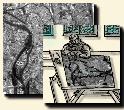 |
 |
![]()
|
|
|
|
|
|
|
|
|
On this mountainous site there is only one road, it appears dark on both channel P ( Figure 29) and XS3 ( Figure 30). Following images are presented reversed for a best legibility.
The result of the MDRO ( Figure 30) is very noisy. The ``valley'' of ISEF ( Figure 32) has detected some wide shapes with the standard filtering rate. This optimal value is never modified in order to have a constant behaviour with any image. The fusion corrects this problem. As only one image is used to detect linear features, the conjunctive is the best way to combine the results of detection.
It can be seen on image 33 that the wide shapes are no more present.
Vectors from the date bases are superimposed on image 34. In this database the errors are very important, up to 1500 meters (150 pixels).
The result of the dynamic programming is shown on image 35. It follows the road, but some noise can be seen, the thickness of the line (3 pixels, for best legibility) hiding most of its effects.
The final result is presented on image 36;
the curve is perfectly smoothed and follows the road without noticeable
error.
|
|
|